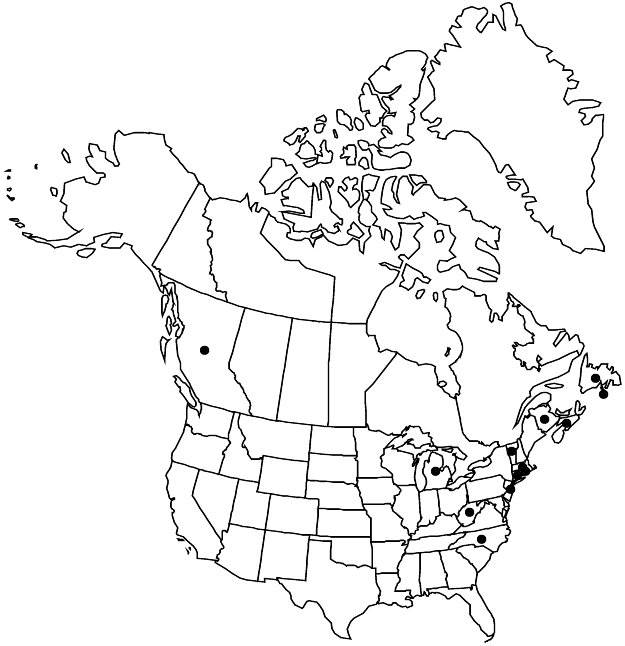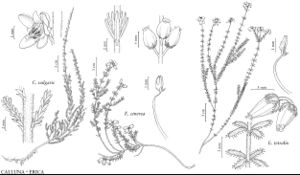Difference between revisions of "Calluna vulgaris"
Brit. Fl. ed. 2, 114. 1808,.
FNA>Volume Importer |
imported>Volume Importer |
||
| Line 5: | Line 5: | ||
|title=Brit. Fl. ed. | |title=Brit. Fl. ed. | ||
|place=2, 114. 1808, | |place=2, 114. 1808, | ||
| + | }} | ||
| + | |special_status={{Treatment/ID/Special_status | ||
| + | |code=I | ||
| + | |label=Introduced | ||
| + | }}{{Treatment/ID/Special_status | ||
| + | |code=F | ||
| + | |label=Illustrated | ||
}} | }} | ||
|basionyms={{Treatment/ID/Basionym | |basionyms={{Treatment/ID/Basionym | ||
| Line 28: | Line 35: | ||
|elevation=0-1500 m | |elevation=0-1500 m | ||
|distribution=St. Pierre and Miquelon;B.C.;N.B.;Nfld. and Labr. (Nfld.);N.S.;Conn.;Mass.;Mich.;N.J.;N.C.;R.I.;Vt.;W.Va.;Europe;w Asia. | |distribution=St. Pierre and Miquelon;B.C.;N.B.;Nfld. and Labr. (Nfld.);N.S.;Conn.;Mass.;Mich.;N.J.;N.C.;R.I.;Vt.;W.Va.;Europe;w Asia. | ||
| + | |introduced=true | ||
|discussion=<p><i>Calluna vulgaris</i> is well known as a constituent of moorlands in northern and western Europe, especially northern England, Ireland, and Scotland. The places where it is naturalized in North America are mostly coastal; inland it often is associated with railroads.</p> | |discussion=<p><i>Calluna vulgaris</i> is well known as a constituent of moorlands in northern and western Europe, especially northern England, Ireland, and Scotland. The places where it is naturalized in North America are mostly coastal; inland it often is associated with railroads.</p> | ||
|tables= | |tables= | ||
| Line 51: | Line 59: | ||
|publication title=Brit. Fl. ed. | |publication title=Brit. Fl. ed. | ||
|publication year= | |publication year= | ||
| − | |special status= | + | |special status=Introduced;Illustrated |
| − | |source xml=https:// | + | |source xml=https://bibilujan@bitbucket.org/aafc-mbb/fna-data-curation.git/src/bb6b7e3a7de7d3b7888a1ad48c7fd8f5c722d8d6/coarse_grained_fna_xml/V8/V8_960.xml |
|subfamily=Ericaceae subfam. Ericoideae | |subfamily=Ericaceae subfam. Ericoideae | ||
|genus=Calluna | |genus=Calluna | ||
Revision as of 00:17, 28 May 2020
Shrubs 15–60(–100) cm. Leaves widely spaced on leading shoots, closely spaced and imbricate on later shoots; blade oblong-lanceolate to ovate-lanceolate, 2.5–3.5 × 0.5–0.7 mm, base auriculate-clasping, surfaces glabrous, keeled abaxially, concave adaxially. Pedicels: bracteoles 6–8 (4 distalmost simulating sepals). Flowers: sepals exceeding corolla, pinkish purple to white, petaloid, 3–4 mm; corolla pinkish purple to white, lobes 2(–3) mm; filaments glabrous; anthers 1 mm. Capsules 1–2 mm, hairy. Seeds 0.5–0.7 × 0.2–0.3 mm. 2n = 16.
Phenology: Flowering late spring–summer.
Habitat: Wet acidic sites in bogs and fens, upland sites in old pastures and roadsides
Elevation: 0-1500 m
Distribution

Introduced; St. Pierre and Miquelon, B.C., N.B., Nfld. and Labr. (Nfld.), N.S., Conn., Mass., Mich., N.J., N.C., R.I., Vt., W.Va., Europe, w Asia.
Discussion
Calluna vulgaris is well known as a constituent of moorlands in northern and western Europe, especially northern England, Ireland, and Scotland. The places where it is naturalized in North America are mostly coastal; inland it often is associated with railroads.
Selected References
None.
